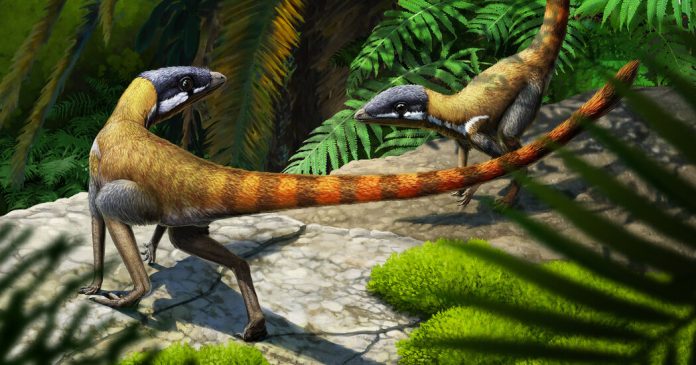Few creatures had been constructed to soar like pterosaurs. Tens of thousands and thousands of years earlier than the earliest birds, these Mesozoic reptiles had pioneered flight with sail-shaped wings and light-weight bones. Ultimately pterosaurs the scale of small planes would take to the sky, pushing the boundaries of animal aviation.
However the origins of those reptiles have remained murky due to a scarcity of fossils from the earliest fliers. “The oldest pterosaur now we have already had wings and had been succesful fliers,” mentioned Davide Foffa, a paleontologist at Virginia Tech, which makes it tough to chart their aerial evolution.
For many years, paleontologists have postulated that the earliest pterosaurs dwelled in timber and experimented with gliding earlier than flying. However Dr. Foffa and his colleagues could have found a extra ground-bound origin for these historic aviators. In a examine printed Wednesday within the journal Nature, the researchers reanalyzed a cache of fossils and concluded that the earliest pterosaur kin had been off to a operating begin lengthy earlier than they took off.
The group examined a number of sandstone blocks that had been excavated across the flip of the twentieth century from a quarry in northern Scotland. Referred to as the Elgin reptiles after a close-by Scottish city, these dense hunks of rock entomb the remnants of armor-clad ancestral crocodiles, early dinosaurs and lizards from the late Triassic Interval, or 237 million years in the past. One of many smallest animals present in these rocks is Scleromochlus, a slender reptile that would match within the palm of a hand.
Since its discovery within the early 1900s, Scleromochlus has perplexed paleontologists. Its fossils are tough to check as a result of the bones disappeared way back, abandoning empty areas inside the sandstone. For many years, researchers have poured latex or wax into these voids to create casts. However these strategies typically miss intricate traits.
So as a substitute of forging guide molds, Dr. Foffa and his colleagues positioned a number of blocks containing Scleromochlus specimens beneath a micro CT scanner. This allowed them to digitally reconstruct the skeleton of Scleromochlus in three-dimensions.
Scleromochlus could appear like a lanky dinosaur crossed with a chameleon. However after additional examination, the researchers recognized a number of traits that Scleromochlus shared with lagerpetids, a gaggle of small reptiles that scurried round Pangea throughout the Triassic Interval. That features an oddly giant cranium for its measurement and a hooked femur head that slots into the hip vertically as a substitute of splayed out to the aspect like a lizard’s leg.
Based on Stephen Brusatte, a paleontologist on the College of Edinburgh and one among Dr. Foffa’s co-authors, lagerpetids seem to have been agile, bipedal creatures harking back to pint-size dinosaurs. Their anatomy, nevertheless, reveals a a lot nearer affinity to pterosaurs. “At a fast look, they give the impression of being nothing like a pterosaur,” Dr. Brusatte mentioned. “However a detailed take a look at their skeletons and the similarities with pterosaurs grew to become obvious, like invisible ink being held to the sunshine.”
If Scleromochlus is an early relative of pterosaurs, it challenges the belief that pterosaurs initially jumped or glided. Scleromochlus lacked the sturdy hips of a hopping animal like a frog and would have been a clumsy slot in timber, in keeping with Kevin Padian, a paleontologist on the College of California, Berkeley, who has studied pterosaur evolution for many years. “They’re long-legged and short-armed,” mentioned Dr. Padian, who was not concerned with the brand new examine. “That’s not how an arboreal animal like a squirrel is constructed.”
As a substitute, Scleromochlus was probably extra comfy swiftly pursuing bugs on the bottom. This left its forearms free, doubtlessly setting the stage for animals in its department of the household tree to ultimately flap. “Utilizing their forelimbs for different capabilities might have been associated to the evolution of recent habits, together with lively flight within the case of pterosaurs,” mentioned Martin Ezcurra, a paleontologist on the Argentine Museum of Pure Sciences who was not concerned within the new examine.
Dr. Foffa stresses that extra fossil proof is required to attach Scleromochlus with the earliest true pterosaurs. “It doesn’t have wings or something loopy like that,” he mentioned. “The loopy comes later.”


